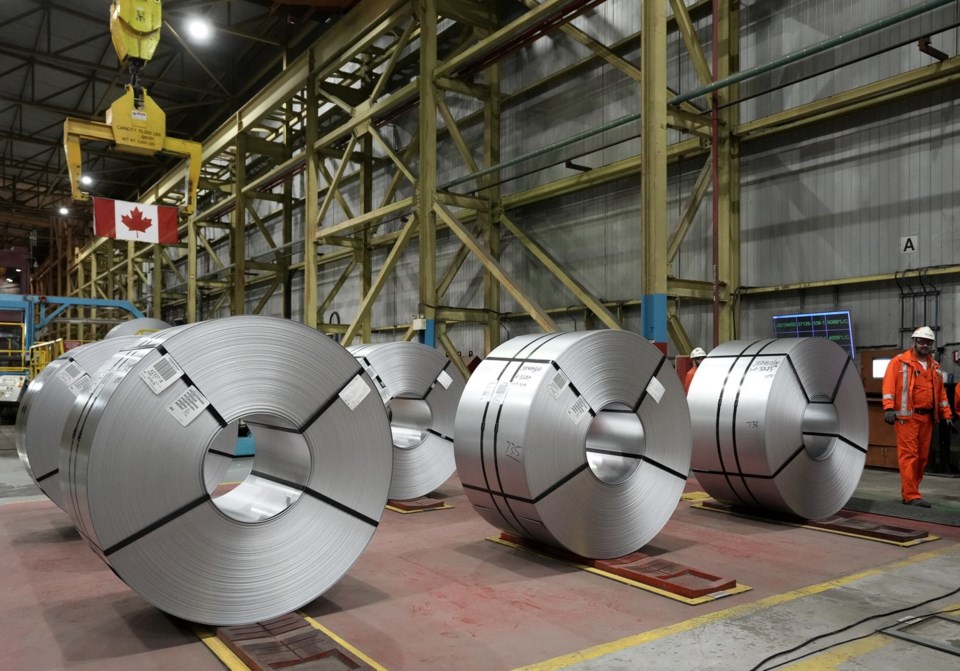TORONTO ŌĆö Impending U.S. tariffs have pushed Canadian companies to stockpile goods, cut back staff, put projects on hold and whatever else they think will help them survive the economic turmoil ahead.
U.S. President Donald Trump has set Wednesday as the day he will unveil his administration's latest tariffs on numerous countries, but hours before the announcement, there was still little indication on their potential scale or scope.
The U.S. already hit Canada and Mexico with 25 per cent levies on steel and aluminum on March 12. In early March, the U.S. also went ahead with blanket tariffs on Canadian goods, only to lift it shortly after for the auto sector and then for all goods compliant with the North American free trade pact, but those exemptions are set to expire with the pending tariffs.
For industries that rely on exports to the U.S., tariffs could be a major hit as customers south of the border may choose to buy fewer goods or switch to U.S. alternatives.
The threats, and the uncertainty that has come with them, have forced all sorts of company responses, ranging from businesses rolling out advertising to emphasize their Canadian ties, looking to secure new suppliers, and holding off on providing financial forecasts because of the huge uncertainty.
The concerns have Charmaine Goddeeris, director of customs and international trade at BDO Canada, taking questions all day from companies trying to navigate the border landscape.
"My calendar is basically full from eight o'clock in the morning to seven o'clock at night, fielding calls," she said.
Many companies that didn't have to think about tariffs at all in the past are having to play catch-up, said Goddeeris, especially since only goods compliant with CUSMA are moving tariff-free.
"For the most part, Canadian businesses don't have good insight into their customs processes, what their customs responsibilities are."
Some with simple products are able to bring them into compliance fairly easily, but for those with more complicated goods with lots of inputs that need to be checked, it's a more labourous process.
Besides trying to get certifications, company responses have been everything from doing nothing and hoping it all passes quickly, to immediate moves to relocate some or even core operations to the U.S., she said.
"I've got this group of clients who are having this knee jerk reaction and they just went straight to setting up shop in the United States. They don't want to explore anything else," said Goddeeris.
"But what ends up happening is they are now shocked by the cost and the bureaucracy of setting up shop in the United States. It's not as simple as just, you know, finding a storefront to rent and throwing up an open sign."
Other companies are taking more measured approaches, talking with clients about sharing the tariff costs and planning to re-evaluate in the months ahead, while some are also accelerating existing long-term plans to check their supply chains and find new customers.
Canadian companies that have announced their own responses to the tariff threat have often talked about adapting to lower demand. Pantyhose-maker Sheertex laid off 40 per cent of its staff, citing the tariff threat, while airlines have been reducing flights to the U.S. as Canadians cut down on trips to the now-hostile nation.
The drop in economic demand can also be seen in S&P Global Canada's latest barometer of manufacturing activity that showed a sharp drop in March, following a decline in February as factories see fewer orders and less output.
The lower activity means 27 per cent of businesses are looking to reduce production capacity or head count, according to a survey from PwC Canada, but companies aren't just accepting the hit ŌĆö almost three-quarters of responding businesses also said they're looking to open or expand operations in other markets.
There have been temporary boosts to economic activity as companies prepare for the tariffs to come in.
Shippers have raced to beat the shifting tariff deadlines, prompting a surge in cross-border cargo traffic. Freight volumes rose 25 per cent year-over-year in January and 58 per cent in February, according to transport data firm Loadlink Technologies.
The short-term boost was seen in January GDP numbers, which rose 0.4 per cent as manufacturing and oil and gas saw spikes in demand ahead of the Feb. 1 tariff deadline that ultimately got pushed back.
The ramp up in demand early in the year will mean a bigger hit later on, said Andrew DiCapua, principal economist at the Canadian Chamber of Commerce.
"WeŌĆÖre really sprinting into a wall," he said in an interview late last week.
ŌĆ£These are sectors that are hit by tariffs and it makes a lot of sense as to why youŌĆÖre seeing this push up in economic activity,ŌĆØ he said. ŌĆ£But thatŌĆÖs going to hurt us in the months to come.ŌĆØ
Small businesses see the writing on the wall as well. The Canadian Federation of Independent Business' latest sentiment check plunged by half in March to a 25 point measure on a scale of 100, the worst on record.
-- With a file from Craig Lord in Ottawa.
This report by The Canadian Press was first published April 2, 2025.
Ian Bickis, The Canadian Press




